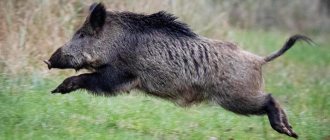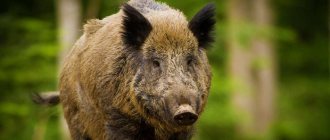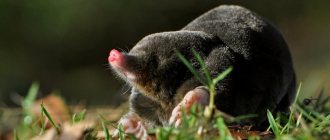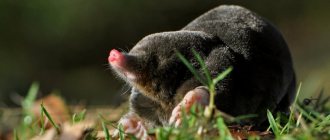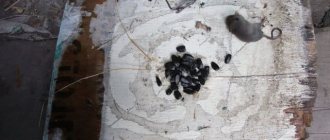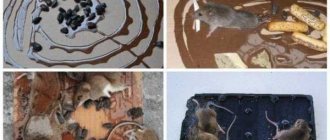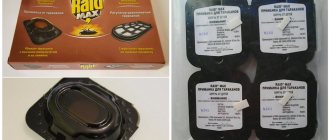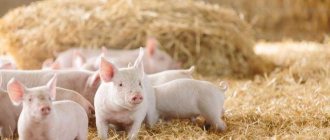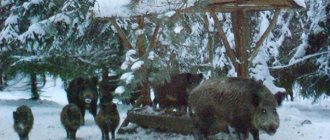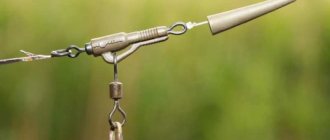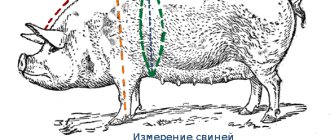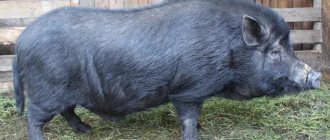Wild boar: appearance and characteristics of the animal
Wild boars can be seen throughout almost the entire area of the CIS. This animal does not have constant and year-round preferred food. They eat food that is available, the most nutritious and easily accessible. It is believed that pigs find most of their food in the soil: such nutrition prevails over above-ground nutrition by more than 3 times.
Wild boars have the largest range of any mammal. There are approximately 16 subspecies of wild pigs. In Russia you can find the Carpathian, Transbaikal and Ussuri subspecies. Due to their different habitats, they have differences in both the structure of the body and its weight. The average weight of a wild boar is up to 150 kg, but in Eastern Europe you can also see specimens up to 275 kg.
Wild boars are considered herd, non-migratory animals that live exclusively within their territory. The herd consists of approximately 30-50 heads, they occupy an area of about 1 square kilometer and defend their possessions. If there is not enough food in the forest, then the animals begin to visit the nearest fields and gardens.
Wild boar diet
What the animal will eat depends on the vegetation growing nearby, which is characteristic of a particular region, and the time of year. The diet of an adult wild boar is varied and rich. Pigs are constantly looking for food, eating large portions and looking for food in fields, forests, near lakes and rivers.
The diet of a wild boar depends on the region where it lives.
Summer diet
In the warm season, wild boars are more likely to choose food high in protein: legumes, table scraps, bird eggs, chafer larvae, earthworms, plant tubers. You can also use other foods with a strong smell: chips, crackers, herring and cat or dog food.
In May or June, wild boars can consume all types of insects, small field and forest rodents. Their special delicacy is snails, various beetles and grasshoppers. They avoid mushrooms, but love to eat oak and pine bark.
In summer, animals love to feast on the larvae of various insects.
Winter diet
A hungry animal is ready to go to any place where food can be found. And in the winter cold it is difficult to get food, so the diet at this time is monotonous. Winter migrations are short-lived; animals should be provided with food daily, 2-3 kg per boar. Products can be both juicy and concentrated.
Boars mainly attack private fields and lands. Using their hooves, they extract potato tubers, beets and carrots from the ground.
With the onset of cold weather, the ground freezes, making it increasingly difficult for the boar to obtain food.
Boars on diesel fuel and rotten herring
If feeding areas are constantly working, and you don’t want to scare the animal into feeding, then feeding and slaughter should be separated. Therefore, for shooting, separate baits are made away from the feeding areas.
Why do wild boars love diesel fuel? Just like rotten fish, the smell of diesel fuel causes wild boars to fall into a state similar to that of cats after valerian. This is a kind of mark, like a dog falling into a dead cat. It stinks a mile away, but the dog is happy. In the summer, covered with a solar film, they escape from the horse flies, gadflies, ticks and other blood-sucking creatures that plague them. The smell of diesel fuel, to one degree or another, is background for them from birth (agricultural machinery in the fields, cars and tractors in logging, summer haymaking, etc.). Some hunters even practice lubricating their boots a little with solarium before each hunt - it covers up the smell of a person and does not cause alertness (but this is not an acquired taste).
SOLAR COVER (CAN BE FROM EXHAUSTING). Boars need to have a place for a “big scratch”, as well as the opportunity to notice a strong smell. It also helps against parasites.
The main types of baits for wild boar are made like this (from the stories of hunters). It is prohibited to do this without known drainage of the site, without the possibility of subsequent selection of soil, and in dry times:
On a puddle
The site of the proposed ambush is being inspected. It's best on the way to the fattening field. He walked around the field he was visiting, identified the most well-trodden paths, and found the nearest watering hole (maybe a small, never-drying puddle). It is into such a puddle that diesel fuel is poured. Don’t worry, pigs always have a couple of “spare” watering holes in stock. The best thing is for the puddle or swamp to be smaller, but even if this is not the case, it doesn’t matter. About 20 liters of diesel fuel are poured out and, for greater effect, 20 or more liters of used oil (not a problem in any auto repair shop).
I poured approximately the same amount onto a non-drying puddle 2 by 3 meters, but this is not strict. The pigs will wait two or three days, after which the pilgrimage will begin. Both singles and herds are suitable. There were nights when the entire puddle was splashed all over the area, leaving only a thick slurry.
After this, you will have to apply water from the nearest reservoir in milk cans. If they started climbing in the middle of summer, they will continue climbing until the cold weather hits. I often just watched them splashing, very funny and interesting. No need for meat, let me admire it. A cleaver the size of a Zaporozhets lies there, and like a kitten, it rocks on its back, rubs itself, its paws are raised up. Very exciting and educational. After use, the puddle soil must be removed.
Wild boars will love your solar puddle so much that they will hide in it not only from mosquitoes, but even from dogs. Dogs cannot stand the solar stench and will not climb into such a puddle after a wild boar.
Per winding
The second method is much more economical and environmentally friendly. But no less “fruitful”. Take a couple of the heaviest bags (from classic burlap, nettle, hemp, etc.) Cut it at the seams. The resulting canvas is as wide as a bag, and two and a half meters long. Take 20-30 meters of good, soft and elastic wire in advance. Choosing a bait location - see above.
Only here, near the feeding trail, you choose a couple of trees growing nearby (from experience, I prefer only deciduous ones, although my colleagues and opponents also used coniferous ones). The distance from the trail can be 30-50 meters. Wrap the tree trunks near the base (along the butt) in a circular shape.
Then carefully (!!!) fix this harness with wire at three or four levels. All is ready. Bring diesel fuel in plastic bottles (1 two-liter bottle per trunk), apply diesel fuel evenly through the perforated lid around the trunk throughout the burlap (baby spray principle). But even at the stage of selecting trees, I advise you to take care of a good field of fire (30 meters so that everything can be clearly seen).
You can have one tree, the smell is the same, but I make two, otherwise they start squabbling and fighting. The solarium should be renewed approximately every three days (it evaporates a lot in the summer). It happens that they rub against the bag so much that one wire hangs and there are rags - replace it with a new one. Knit the bag as low as possible, otherwise the little ones will feel uncomfortable (and you need to respect the animal and take care of its comfort).
It won’t work on a whim (arrived, spilled diesel fuel, slammed it, left). At least five days or a week will pass before it’s worth sitting down for the night.
On eggs
Exotic, but effective for both amateurs and professionals. You need to take eggs from a slaughtered breeding boar (even better if you manage to cut them from a wild cleaver from a hunt). Just so that the boar is “untied” (eggs of piglets castrated on pig farms do not give the desired effect). If you don’t go “fishing” right away, then you can store as much as you like in a bag and in the refrigerator or freezer.
Before going hunting, defrost the eggs to normal temperature. Shred them into relatively small pieces. Throw it into some container (I stuffed it into two five-liter plastic bottles) and fill it with ordinary water (preferably well water). Let this whole thing sit for 12 hours, maybe a day (just not in the heat!).
You probably already know the trails and places most visited by wild boars. When you arrive at the hiding place, you spray some water on the bushes, along the tree trunks, then shake out of the bottles what was once the “pride of the boar.”
We just have to wait. It works especially well in November-January. The boars are already overexcited, each of them is “in a creative search.” The whole calculation is based on this desire to compete with another boar. However, in this case, you will not get a wild boar going for feeding, but especially a cleaver and a large wild boar (they fly straight to the smell). The boar is excited and aggressive to such a bait, make allowances for this in your actions
The smell of boar pheromones spreads quite a long distance, so the animal will approach even from the neighboring kilometer block. It’s worse when they have a tournament somewhere nearby, then more than one can come, with an interval of half an hour. And from now on, I advise you to take the cut eggs from hunts, they will come in handy.
What else does a pig eat?
The plant diet of wild pigs consists of terrestrial parts of plants. They love alfalfa, dandelions, wild grains and holly. In swampy areas they can eat sedge, reeds and calamus. Unusual plants that can be used include nettle and anemone flowers. Due to differences in flora, wild boars in different regions of the country eat differently. So, next to the Volga, these animals feast on reeds and cattails.
It is also known that wild boars love overripe fruits of apple, pear and plum trees.
Wild boars love to eat fruits of apple, pear, and plum trees that are overripe and fall to the ground.
However, the wild boar's diet is not limited to plants and insects. In critical conditions, they can also feed on meat, eating the bone remains of large forest animals. If carrion is found, a family of wild boars may feed on it for a long time until the carcass is gnawed down to the bones, and then they are eaten too. They can independently catch waterfowl, muskrats and water rats.
Wild boars also happily eat bird eggs and fish, and do not disdain leftover food and sweets.
What do wild boars eat at home?
A pet eats much more noblely, and certainly not on bones and carcass remains. The wild boar at the farmstead prefers high-quality food and eats a lot of food per day, up to 5 kilograms of food. Currently, pig owners are increasingly switching to compound feeds and concentrates, and also feeding their pets food waste. In the villages, they cook porridge the old-fashioned way and give the pigs a mash of potatoes, bread, and bran. Fresh green grass and mineral supplements are required.
The boar's main home diet is grains (oats, wheat), cereals (necessarily corn, peas, but not much), green fresh feed (in summer). Various vegetables, fruits, plant tops, as well as freshly cut grass (clover, fireweed). Both domestic and wild pigs are well versed in herbs, and will never eat a poisonous plant, nor will they chew burdock. These animals are very fond of milkweed and dandelions, but quinoa, which an adult pig readily eats, should not be given to piglets, as they can be poisoned.
Boar breeding
The wild boar is an unpretentious animal, not picky about food. But in order to raise a healthy animal and increase their numbers in the hunting area, a number of measures should be taken to feed and maintain game.
Gamekeepers and game wardens closely monitor changes in the number of wild boars in hunting areas. Due to the systematic shooting of wild pigs, a constant increase in the number of animals is required - this is the main goal of the gamekeeper.
Gamekeepers monitor the number of livestock on the hunting grounds
In Russia there are many places that are suitable for living and breeding of wild boars. Even in those territories where the wild boar has never lived, the animals are actively settling with proper protection and feeding. The result is successful hunts.
Feeding encourages the boar to stay in place. In this case, the increase in livestock can reach 30% compared to last year’s winter count.
Most of this increase will be shot by hunters and poachers, so no matter how much the pig population increases, it will not increase significantly.
Basic principles of wild boar hunting
It is not enough to simply pour in feed so that the boar can easily approach the hunter. Boar hunting is a whole science that does not tolerate thoughtless actions. And you should remember the basic rules:
- It is prohibited to shoot in the feeding area; for this it is necessary to arrange a separate ambush.
- If the target is in constant motion and does not allow an accurate shot, then you can whistle, and then the wild pig will freeze, standing on its hind legs.
- It is not recommended to visit a hunting area without a partner and a gun, because a wild boar is a wild animal that will defend itself until the very end.
It is prohibited to hunt wild boar in the feeding area.
Chasing wounded animals without dogs in the dark is also dangerous.
Why do you need feeding?
During frosty winters with heavy rainfall and ice, natural food supplies become inaccessible to wild pigs. As a result, there is a catastrophic decrease in the number of these animals, especially young individuals aged 8 to 11 months.
In conditions of poor harvest and harsh climate, the number of wild boars can be reduced by 2 times. However, if the harvest is good and the winter has been warm, the size of the pig population can increase significantly.
Feeding is one of the main conditions for successful breeding of wild boars in hunting grounds
However, you can’t rely solely on the weather, so to preserve and increase the number of wild boars, you should not only protect the animals from predators and poachers, but also organize winter feeding.
Among other things, feeding helps keep animals in one place.
Piece by grain
It is impossible to feed wild boars, but it is possible to support them in difficult times. Usually once a week a couple of bags of oats and two or three buckets of potatoes are poured out. Sprinkle the oats not in one heap, but in several small portions at a distance of 5-8 meters from one another. This makes it possible for both young animals and adults to feed at the same time without interfering with each other. In a bypass of three fields, hunting is carried out in only two, one field remains “reserved”.
As for “feeding” the livestock, this is practically unrealistic, since such expenses cannot be justified by any livestock. An adult boar needs approximately 4 kg of dry food per day. Accordingly, for example, for 70 Dolgolugovsky wild boars - For six months: 180 days x 4 kg x 70 wild boars = 50,400 kg of dry food. Of course, we can only talk about feeding, and not about feeding.
The bait is organized according to the following distribution standards: root crops 1-1.5 kg; grains 0.5-1.0 kg. Standards for an adult.
Periods: November 15 - December 1 - 1/4 of the recommended daily intake; December 1 - January 1 - 1/2; January 1 - March 15 daily norm.
Photo — Andrey Shalygin
However, there is one small “BUT” here too. If heavy snow falls for a short time, then the wild boars gather in large herds, make wide paths for themselves and thus escape for some time. But this cannot continue all winter, since due to the high concentration of animals in a small area, a shortage of feed occurs very quickly. It’s almost as if all the residents of the city suddenly started going to only one store...
Therefore, in winter, in high snow, it is necessary to make paths for wild boars with snowmobiles, arranging for them an extensive system to bypass several areas, as well as access to natural feeding areas. Of course, the wild boar will also use existing roads for transport. Therefore, they need to be equipped with appropriate notices and made detours around them. If a wild boar comes out onto the road, it means there is not enough space and conditions for it along the paths in the forest, or the number has gone through the roof.
What bait is suitable for wild boar
In addition to food baits, a certain number of scent baits are used, which can affect the outcome of the hunt. Since the wild boar mainly picks up food from the ground, the bait is left in a specific place or in a pre-dug hole.
Flavors
There are many synthetic products that imitate the smell of a male. Special scented candles that can attract a herd have a similar effect. They must be lit and rotated at an angle of 45 degrees, as a result, the odors spread within 20 minutes.
Special scented candles imitate the scent of a male
The flavoring has the desired effect in any weather for up to several hours, and is also biologically safe. However, it should be remembered that as humidity and temperature increase, the rate of evaporation of aromas increases. Both the strength and direction of the wind influences it. The gel is applied to the soil along the path that leads to the hunting area. If you want the animals to stay in place longer, add cake or mixed feed.
The most popular use of additives in Russia is based on grain crops. Resinous brown liquids with a smoky smell and a mixture of fruit and corn oils with a mushroom aroma perform well. Also, baits may include analogues of female or male urine, the smell of fermented fruit and smoldering sticks.
Popular baits for wild boar are additives based on grain crops
The set of odors is determined by the boars’ reaction to them. It should be remembered that too strong a scent can scare away, the smell should be insignificant. However, the smell of the food should be as strong as possible.
Diesel fuel
Many hunters know that wild boars are very attracted to the aroma of diesel fuel, which is why wild pigs love to rub against treated surfaces. There are several methods of driving using diesel fuel, but all of them are prohibited during those seasons of the year when it is impossible to remove soil watered with diesel fuel.
You can lure a wild boar in summer using diesel fuel
In a puddle
First, you should inspect the site of the future ambush, which should be placed on the road where animals go to their feeding places. Then they study the identified well-trodden paths and find a watering hole, which can be a non-drying puddle. You need to pour 20 liters of diesel fuel and the same amount of used oil into it.
In a couple of days, first several wild boars, and then whole herds, will begin to visit the puddle. In this way, pigs are saved from parasites and wild animals that will not follow them into such a puddle. Sometimes the water splashes, after which only thick liquid remains in the puddle. Then you will have to fill the puddle again.
As bait for wild boars, use a shallow puddle into which 20 liters of diesel fuel is poured.
It is recommended to treat nearby bushes and trees with the oil used. Some hunters also coat the soles of their boots with diesel fuel so as not to make wild boars too wary.
Animals will visit such an attractive place from summer until the cold weather. Then you should definitely remove the used soil and take it away.
Per winding
This method of baiting does not harm nature and is the most economical, but no less effective. You need two or three canvases up to 2.5 m long each. You will also need soft and elastic wire up to 30 m in length.
The landing site must be visible so that shelling can be carried out within 30 m. Afterwards, a wrap is installed on the trees that grow about 30-50 m from the boars’ passage path: burlap is wound around the bases of two or three trunks so low that the piglets can also reach it and firmly fixed with wire at several levels.
Baiting a wild boar using a winding is an economical method that does not harm the environment
Diesel oil should be applied evenly to the canvases around the entire trunk: one will need about 2 liters of diesel fuel. The manipulation should be repeated after three days, and even earlier in the hot season, as the smell quickly evaporates.
Due to the fact that individuals may rub too hard against the bait, the burlap may wear out and then it will need to be replaced.
Hunting can begin after a week.
Labaz
If hoof marks, broken stems, or chewed cereals with discarded husks are found on dry ground, it means that a place where wild boars regularly visit has been discovered. It turns out that you can prepare a storage shed.
To do this, transverse strips are knocked down on trees at a height of about 5 meters, a footrest is made, and a hook or nail is nailed to store the gun. 40 minutes before sunset, you need to climb onto the storage shed with binoculars, after rubbing yourself with insect repellent cream.
A storage shed on a tree is the most suitable way to set up a hideout that a wild boar will not be able to smell and recognize.
If you hear the cracking of branches or birds suddenly rise into the sky, it means that wild pigs are somewhere nearby. It is worth remembering that the animal can lie down in the field for several days, and it can also be scared off by predators, dogs or other hunters. Therefore, you will need to muster all your perseverance and tenacity to wait for the catch.
Forage crops
To ensure regular hunting, hunters or rangers sow a certain area with forage plants, with special preference given to millet, Jerusalem artichoke and potatoes. These crops are not only unpretentious, but part of the harvest harvested in the fall can be used for winter feeding.
To maintain the number of wild boars in hunting grounds, special feeders are built into which grain is poured
Non-standard bait methods
How else can you feed a wild boar: sometimes grain is placed in a plastic bag and an incision is made. Thus, the grain does not suffer from weather conditions, and wild boars can come to the place several times.
It is known that wild boars really like herring, but they can easily get poisoned by it, so you definitely shouldn’t overuse this complementary food. It's better to use it solely for scent.
Wild pigs also like fragrant beer, so you can take the wort after brewing.
However, the best method of bait remains the use of a decoy pig; it can be used all year round, with the exception of winter.
Eat up with nickels
What are zootechnical measures to support the number of wild animals in hunting areas? The main and main thing is feeding. Experienced huntsmen know that even such a hardy animal as a wild boar can find it very difficult to get food in unfavorable natural conditions (drought, severe frosts, prolonged downpours, heavy snowfalls). In order for wild boars to “boar” (in the literal sense of the word) and be able to produce healthy and hardy offspring, fodder fields are set up on the hunting farm, which are sown with grain crops. In forest belts, special feeders (troughs) are built in which grain is poured. In addition to grain crops, the boar feeding menu includes baked goods and, without fail, salt.
Salt is necessary for the normal functioning of any body. Wild animals have a hard time, because it is very difficult to find salt in the forest. Special salt licks for wild boars are installed in places where they constantly feed.
The enclosure keepers know very well that if the wild boar herd is limited in its movement even a little, they will sweep out the enclosure to such an extent that even no grass will grow in it over a huge area.
Feeding wild boars in certain places of the hunting ground is not only aimed at increasing the number of animals. Constant feeding “ties” the boar to one place, which greatly facilitates the subsequent process of hunting it, because the huntsman will know for sure at what time and in what place the boar will appear.
In addition to providing additional feeding and additional watering places (in dry weather), the farm’s rangers also take care of the health of the wild boars. Wild boars, like domestic pigs, are big fans of wallowing in the mud. Adding regular diesel fuel to the “bathing” areas of wild animals helps wild boars get rid of insects - parasites that live on the skin of animals, and protect themselves from annoying gadflies, mosquitoes and midges. Having wallowed in a puddle of mud mixed with diesel fuel, the boar goes about its boar business, while the dirt and diesel fuel, drying on its hair, turns into a kind of shell that prevents insect bites and gets rid of fleas.
How is boar bait used?
With the help of fertilizing, you can achieve retention of wild boars in one place to facilitate their shooting. If it is not possible to replant, then they organize a place for constant feeding. To determine the best bait option, several types of bait are formed, and then the preferences of local animals are observed. Also, the effectiveness of the bait depends on the regularity of its updating.
Any clearing where there are boars is suitable for temporary feeding. For permanent ones, it is better to pay attention to specially equipped places where it is easy to track individuals and hunt.
A clearing where wild boars come out in search of food is suitable for temporary feeding.
Find feeding areas or wild boar trails
An important part of the hunt is to find out the habitats of the animals, their favorite bodies of water and bedding areas. It must be remembered that the wild boar remains only in the region for which it is most suitable for this; sometimes this may not depend on the feeder.
A simple bait to determine if there is a wild boar nearby
Luring boars consists of attracting them to a place where hunters are waiting. In this case, bait that is based solely on the smell of food will not help. This option can be used only when the animal needs to be pointed to the place of feeding during the hungry period. Then it will be possible to lure the animals to a new bait site. To delay it, it is necessary to constantly provide additional feeding until the place becomes familiar.
To keep animals near the feeder, it is necessary to regularly lay out feed
But it should be remembered that a wild pig will become interested in a place only when it sees the food, and not just smells it. The animals must discover the place as if by accident. To do this, you need to place the bait directly on the animal’s trail, because sometimes even food located a few meters from the animal’s path is not noticed.
Increased feeding time
If it is necessary for the animal to get used to a new place, you should constantly organize the supply of food and flavorings. Then this place will become familiar, and new individuals may begin to visit there.
Using automatic feeders
Expensive professional feeders equipped with a timer, waterproofing, and a photo recorder, which are used with non-freezing feed, will help you avoid difficulties.
An automatic feeder will ensure regular feeding of wild boars with healthy, tasty, dry food
Borya-borya-borya...
Feeders for wild boar: as a rule, they do not have any special device. The boar takes food only from the ground, so most often the food is simply dumped on the ground or in a hole specially dug for this purpose. Arranging a canopy is not necessary if it is regular feed and not special feed (which is washed away by precipitation).
Usually, on the site of one round (12-15 thousand hectares) 3, less often 4, fertilizing are done. If funds and desire allow, then the number of sites can be significantly increased - this is only a “plus”. Most often, in order not to bother, huntsmen immediately make salt licks, hay for the goats, hang brooms, and solar blankets. But this is more likely to save your own effort and money - because. if the boar came to eat, then the goats and all other animals will leave there for the duration of the pig snack.
It is possible to clear the area (and dig a silo pit) for fertilizing, and the access to it, in the summer; they begin to export feed in September-October; if you start earlier, the exported feed begins to germinate and becomes unusable. Little by little, exports are constantly renewed, until February-March.
Grain waste, corn (both in grain and on the cob), various root crops and feed are used. The volumes depend on the livestock, but in any case, one delivery is no less than a car, since otherwise the biochemical reaction of ensiling does not occur.
Grain waste is laid out on a cleared area with the turf removed, creating a “cushion” that can be torn apart with the nose.
For feeders, you can use simple barrels. Or, two holes of approximately 20X20 are cut out from the sides opposite each other in the lower part and a sheet of rubber from a conveyor belt is attached from the inside, and the barrel is mounted on a platform with sides (as in the photo). An inverted bucket is placed inside the barrel and the wild boars manage to drive out every single grain. A very convenient thing if you don’t have the opportunity to feed every day. A barrel holds 4-5 bags of grain and is usually enough for a week. To prevent the grain from sticking into the barrel, we place a couple of sticks on the crosspiece so that the ends stick out from the corners, then the wild boars themselves loosen the grain in the barrel. Grain consumption is sharply reduced compared to laying it out on the ground or in a trough. Typically, wild boars trample more into the ground than they eat. Everything is very neat here.
The wild boars cling to the barrel - tightly.
For small piglets, a fence is made, through which adults cannot go inside and take food from the baby. The distance between the reshts is 20-25 cm:
Young animals can be allowed inside not only by the width, but also by the height of the opening. The width pass is more effective, since it allows thin people to pass through, but in this case you need to look at the screens for “stuckness.” Climbing holes from below also have a disadvantage in crawling through, for which a support log is fixed at the very bottom to prevent undermining and squeezing sideways of large individuals.
What difficulties might you encounter?
It is worth remembering that it is almost impossible to organize ideal feeding that can be easily controlled, invisible to people and located in the wild boar’s habitat.
There are certain difficulties in summer feeding. If the crop ripens earlier, then wild boars can eat it before the hunting season begins, and due to frequent rains, the crops will sprout, but will not ripen, and the animals will not eat them.
It is also worth considering that the food must be placed so that it is accessible only to wild pigs and not to other animals. Diameter or size restrictions on access to feeders are also important; without them, young individuals will not have access to food. It is better to organize food over a large area in the absence of snow.
The feeder should be positioned at a level so that the boar can easily get food
Selective shooting of wild boar
Selective shooting plays an important role in regulating numbers, forming a highly productive population and preventing the spread of infectious diseases.
But very often it is carried out incorrectly, guided by the principle “the main thing is optimal numbers,” without caring at all that thoughtless shooting can harm the population.
It is important to understand that it is necessary to maintain a certain ratio of all age-sex groups in the population, and only after a correct assessment of all these groups is it permissible to extract the least promising individuals. However, it often happens that during selective shooting those individuals are destroyed that, after several years, could become excellent fertilizers.
This has a detrimental effect on the quantity as well as quality of the population.
Selective shooting should include individuals with physical disabilities. To avoid weakening and decreasing the number of the species, selective shooting is carried out.
So, if a physically inferior female gives birth to inferior offspring, and they subsequently form a degraded population. In this case, the female and her entire brood are shot.
At the same time, strong females are the basis of a high-quality population, and when they are shot, orphaned fingerlings cause the greatest damage to agricultural crops, and if in the first year of life they are not provided with conditions for full development, including mother’s milk, in the future they will not be able to catch up and develop into physically strong animals.
The basic principles of shooting are that individuals of all age groups are removed, but in different proportions:
- 90% of the shooting volume is occupied by first-year gilts and gilts (65% and 25%, respectively);
- 10% - females and loppers that have reached adulthood, spawning females that have not had litters in the last 2 years;
- gilts weighing less than 40 kg;
- first-year children weighing less than 20 kg;
- first-year gilts and gilts with spotted, light or black color;
- individuals with a yellow or light shade of color;
- Shooting of healthy leading females is strictly prohibited.
By following these simple rules, you can keep the population at an optimal level and prevent harm to agriculture and hunting.
How to set up a feeder for a wild boar
Feeders are installed in hunting areas from which wild boars feed. They should be filled mainly with the food that wild pigs love most and which will attract them. Feeding begins at the end of summer, and the feeder is periodically replenished throughout the winter.
Boar feeder from a barrel
Feeders with barrels tied to them are often used. In this case, the barrel acts as bait, which detains the animals on the site. A hole is made in the walls where corn grain is poured. However, this is considered an unfair way to attract and hold large numbers of animals for long periods of time.
A feeder with a barrel tied to it acts as a bait that detains animals on the site
Territory for complementary feeding
Typically, four areas for feeding wild boars are formed on an area of 15,000 hectares. A larger quantity is acceptable; this will only increase efficiency. It is worth considering that when these animals eat, they do not tolerate close contact, even with other relatives with separate feeders.
Feeding fields for wild boar
Part of the harvest from the food fields remains in the ground to give the wild boars the opportunity to rummage and get food on their own. At the same time, a small pond is dug nearby to provide water for the animals.
A canopy is set up next to the field, under which grains, for example, wheat, vegetables, fruits and bakery products, are scattered. In summer, you can also install baths with diesel fuel, and in winter, a salt lick to regulate the biochemical processes in the pigs’ bodies.
It is advisable to locate feeding fields for wild boars near a pond
Feeding areas
Oats are not laid out in piles, but are leveled in portioned layers at intervals of about 5 meters. The distance allows young and mature individuals to feed comfortably at the same time.
You should find a secluded place in the forest where there are trees of medium thickness in order to scatter several bags of grain around them. You can make many such piles, it all depends on the collected grain reserves.
Salt is poured around the heaps, which is considered an excellent additive for wild boars, and in addition, it solves problems with the appearance of a crust of snow on the surface of barley.
Planted corn
It is almost impossible to make such fertilizing that strangers will not find. Therefore, the arrangement of feeding should be chosen not only based on the wild boar’s habitat, but also for ease of control.
However, if you just set up a site in the fall, nothing will come of it at all. The boar must be left to live in the area if it appears there. To do this, in the summer you determine the places of more or less permanent habitat of wild boar families, their day and night transitions. In the area with the highest probability of wild boar habitat, plant fertilizing fields in the fall (the field area is at least 2.5-3 hectares).
To prevent the wild boar from leaving the field area, a feeding area is installed next to the field. A feeding area is equipped under a canopy, where grain, potatoes, corn, apples, etc. are scattered, a bath is made with waste or diesel fuel in the summer, as well as a salt lick in the winter.
If a fertilizing site is organized not far from farmland and in sufficient transport accessibility for agricultural machinery, then it can be conveniently plowed, weeded out, and cleared of grass, immediately sowing both fodder grains and root crops.
In the places where you will sow the feeding field, think in advance about hiding places, as well as about feeding for hunting when the fields are over. Place fields and fertilizing areas away from access areas of vehicle hunters (farmers) and do not forget to organize control to prevent their access to the fertilizing areas area.
However, one should not think that even planting a corn field will dramatically change the situation with wild boar. Not so. Lands and their suitability for housing a certain amount of game are assessed according to quality classes (class 1 is the highest, class 5 is the lowest). According to regulatory documents, fertilizing on sites and feeders does not affect the quality class of land at all!
They counted and shed tears. Only crop fields begin to influence the number of wild boars, and then only if there are at least 20 hectares of them per 1000 hectares of land. Then the quality class will increase by 0.2... For example, you have a not very high 3rd class of land quality for wild boar. This means that ideally there could be a maximum density of 6 animals per 1 thousand hectares. Even if you sow 20 hectares of land for every 1000 hectares of land, you will raise the quality class to 2.8. And this means not 6.0 wild boars per 1000 hectares, but 6.6 wild boars per 1000 hectares. A big difference ? No.
Well, even if you raise the quality class by half a point (and this is a lot), then you can ideally have 7.5 wild boars per 1 thousand hectares versus 6.0 without feeding... And feeding itself simply concentrates animals in territories known to people and this creates an opinion that the boar has become much larger...
Some tips
Feeding stations should not be installed near grazing areas of domestic animals. You can save the harvest by planting strips of rapeseed, Jerusalem artichoke or corn in the path of animals. The most effective option is to plant individual target fields far from the main ones.
It is prohibited to set up feeding stations for wild boars near pastures.
If you lure with salt lick, it can also lure other animals, for example, deer, elk or roe deer.
Wild boar hunting with bait is much easier. At the same time, the desired effect and interest from the hunting process is not lost. There are many types of bait, and their correct use can direct wild boars in the desired direction.
Have you had experience hunting wild boar with bait? What was used in this capacity? Share your experience in the comments.
Wild boar: appearance, habitats, nutrition
The wild boar, also called boar or wild pig, is a cloven-hoofed, non-ruminant mammal of the genus Porcine. It is the ancestor of the common domestic pig.
It differs from the domestic pig in its appearance: a shorter and denser body, more powerful and longer legs, a more elongated head shape and sharp erect ears.
The boar has constantly growing upper and lower fangs that protrude upward from the jaw, and in the male they are much more developed than in the female.
The color of the boar's bristles is black-gray-brown, the muzzle, tail, lower legs, and hooves are black. The color of a boar's bristles can vary greatly depending on the location and age of the boar; there are both completely black boars and light-colored, almost whitish boars. On the back of the boar, the bristles form something like a mane, which puffs up when the animal is excited.
The weight of a wild boar is most often up to 100 kg, but sometimes there are individual individuals weighing up to 150-200 kg, and sometimes more. The height of the boar at the withers reaches 1 meter, the body length can reach 175 cm.
The wild boar prefers to live in mixed and deciduous forests, in steppe areas. In Russia, the wild boar lives throughout the European part of Russia, the Caucasus, and Southern Siberia. The wild boar is not found only in the tundra and some taiga areas.
The wild boar is an omnivore; it eats fruits, plant roots, acorns, nuts, and sometimes eats small animals and carrion. If there are agricultural fields near the habitat of a herd of wild boars, then the wild boars feed on them with pleasure, eating potatoes, grain crops, and corn.
Wild boars often settle in swampy areas overgrown with reeds and bushes. Choppers usually stay separate from the herd, joining it only during the rutting season. The herd of wild boars consists of females, this year's cubs and last year's young animals of both sexes.
The wild boar rut occurs from November to January; at this time, the loppers behave aggressively and fierce fights often occur between them. The female's pregnancy lasts 18 weeks, and the litter contains up to 12 piglets.
Boars are capable of reaching speeds of up to 40 km/h, they are excellent swimmers and are able to overcome large expanses of water. Boars have excellent hearing and sense of smell, but poor eyesight.
Wild boars lead a mainly twilight and nocturnal lifestyle; they spend the entire night in search of food, while covering considerable distances. During the day they rest in secluded places specially chosen for this purpose.
